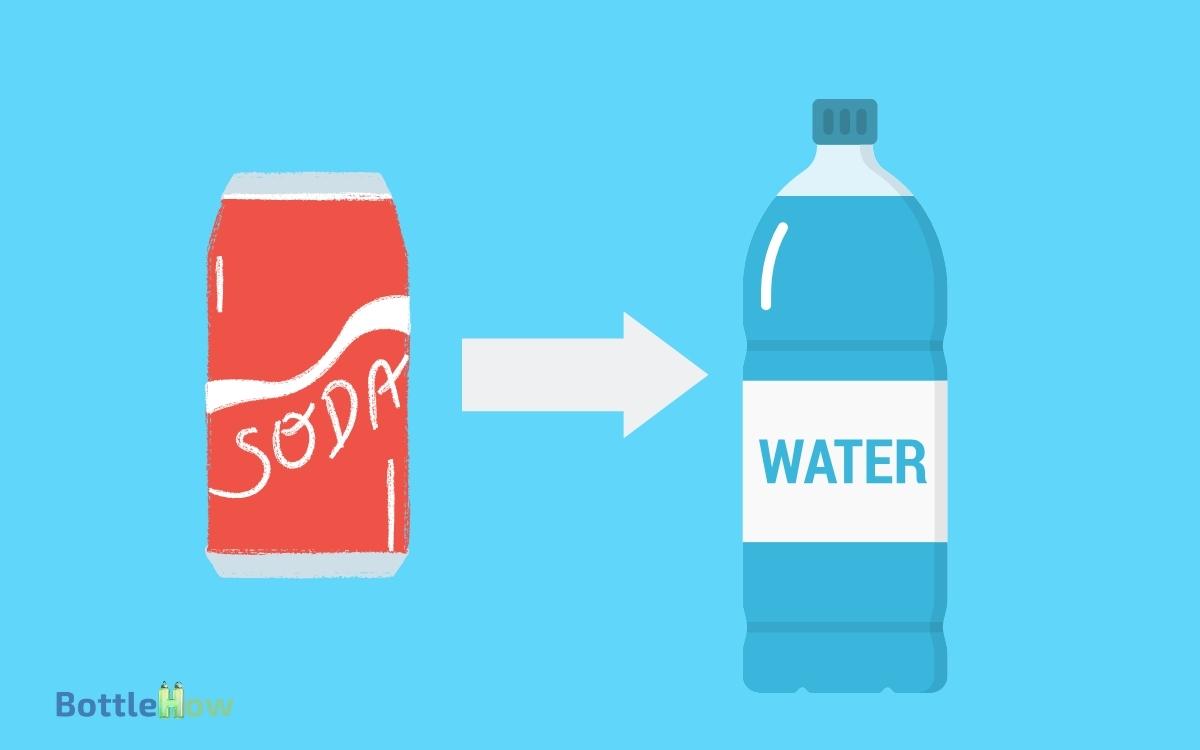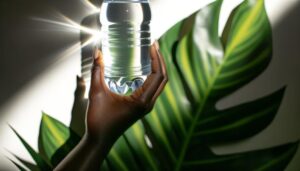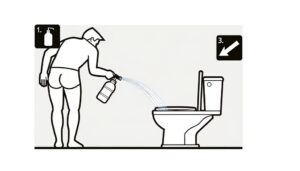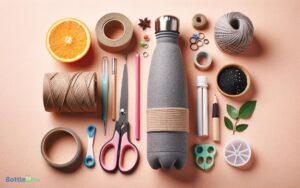Can You Put Soda in a Water Bottle? Yes!
You can put soda in a water bottle, but you need to be cautious. Plastic bottles may react with the soda’s acidity and may not be BPA-free.
Carbonation creates pressure that can compromise the bottle’s integrity, especially if it’s not designed for fizzy beverages.
Porous plastics can absorb flavors, affecting taste and reducing carbonation. Consider using food-grade stainless steel or glass bottles to prevent these issues. Always guarantee the bottle is tightly sealed and check for signs of stress.
Proper maintenance and cleaning are essential to prevent lingering odors and stains. Learn about suitable materials and best practices to ensure safety.

Key Takeaways
Bottle Material Considerations
When deciding whether to put soda in a water bottle, you should first consider the material composition of the bottle to avoid potential chemical reactions or structural failures.
Polyethylene terephthalate (PET) bottles commonly used for water can sometimes react with acidic components in soda, compromising the bottle’s integrity.
Additionally, if you’re using a stainless steel bottle, make sure it’s 18/8 food-grade to prevent leaching of metallic flavors or toxic substances.
Glass bottles, though inert, are prone to breakage under pressure.
Always check for BPA-free labels on plastic bottles, as soda’s acidity can cause BPA to leach out, posing health risks.
Carbonation and Pressure
As a result, when you put soda in a water bottle, the carbonation creates significant pressure buildup. This pressure can exceed the bottle’s material strength, leading to potential ruptures or leaks.
Hence, you should be cautious and consider the bottle’s design specifications for handling pressurized liquids.
Pressure Buildup Risks
Have you ever considered the risk of pressure buildup from carbonation when putting soda in a water bottle?
Carbonated beverages contain dissolved carbon dioxide, which creates pressure inside a sealed container. This pressure increases substantially if the bottle is agitated or stored at higher temperatures.
Water bottles are typically designed to hold still liquids and may not withstand the internal pressures generated by carbonated sodas. The risk of the bottle deforming or even rupturing is real, which could lead to spills or injury.
Understanding the dynamics of gas pressure in confined spaces is important. Always make sure any container used for carbonated beverages is rated for such use to prevent accidents. Being cautious about pressure buildup can protect both you and your belongings.
Bottle Material Strength
Understanding the strength of bottle materials is crucial when considering the use of water bottles for carbonated beverages. Different materials exhibit varying levels of durability under pressure from carbonation.
| Material | Strength Level | Suitable for Soda? |
|---|---|---|
| PET Plastic | Moderate | Yes |
| Aluminum | High | Yes |
| Glass | Variable | Caution |
PET plastic can typically withstand moderate pressures but might deform over time. Aluminum bottles offer high strength, making them ideal for carbonated drinks. Glass, while strong, can be variable based on thickness and quality, posing a risk of breakage.
Always verify that the bottle’s design specifications align with the pressure from carbonation to prevent potential hazards.
Taste and Flavor Retention
Ensuring the full retention of a soda’s taste and flavor in a water bottle can be challenging due to material interactions and sealing effectiveness.
Plastic bottles, for instance, are more porous than glass or metal, allowing CO₂ to escape, which impacts carbonation levels.
Additionally, certain plastics may absorb flavors, leading to a diminished soda experience. The importance of the bottle’s seal is vital; even minor leaks can result in a loss of fizz and flavor over time.
For best taste retention, consider using bottles specifically designed for carbonated beverages. These typically have tighter seals and materials less prone to flavor absorption.
Always make sure the bottle is thoroughly cleaned to avoid any residual flavors from previous liquids.
Safety Concerns
When you pour soda into a water bottle, you must consider the material’s safety, as certain plastics may not be designed to withstand carbonation pressure. Improperly rated bottles can lead to pressure build-up, posing a risk of bursting.
Additionally, chemical leaching from the bottle material into the soda can pose health hazards.
Bottle Material Safety
Before you put soda in a water bottle, it’s crucial to verify if the bottle material can withstand the acidic nature of carbonated beverages. Some materials may degrade or leach harmful chemicals when exposed to soda.
Here’s what you need to take into account:
- Plastic (PET): Generally safe but may degrade over time, potentially leaching chemicals like antimony.
- Stainless Steel: Usually safe but ensure it’s food-grade to avoid nickel or chromium leaching.
- Glass: Highly resistant to acids but prone to breaking under pressure.
- Aluminum: Often coated with a liner; verify it’s BPA-free to avoid chemical contamination.
Understanding these material properties ensures you choose the safest option for storing soda, mitigating health risks.
Prioritize safety by checking material specifications before use.
Pressure Build-Up Risks
Storing soda in a water bottle can lead to significant pressure build-up, posing serious safety risks due to the carbonation. When carbon dioxide in the soda is trapped, it exerts pressure on the bottle.
Water bottles are not designed to withstand this internal pressure, increasing the risk of rupture or explosion.
| Risk Factor | Impact | Mitigation |
|---|---|---|
| Pressure Build-Up | Bottle rupture | Use pressure-rated bottles |
| Cap Dislodgement | Sudden release of soda | Guarantee secure sealing |
| Structural Failure | Potential injuries | Avoid using thin plastics |
You should be cautious and consider using containers specifically designed for carbonated beverages to minimize these risks. Inadequate containers can lead to unpredictable and hazardous outcomes.
Chemical Leaching Concerns
Beyond the physical risks, using a water bottle for soda can also lead to chemical leaching, where harmful substances from the plastic may contaminate the beverage.
This is particularly concerning due to factors like acidity and carbonation enhancing the leaching process.
You should be aware of the following:
- Bisphenol A (BPA): Found in certain plastics, BPA can leach into your drink and disrupt endocrine function.
- Phthalates: These chemicals can migrate into your soda, potentially causing reproductive and developmental issues.
- Antimony: Often present in PET bottles, antimony exposure can lead to gastrointestinal issues.
- Styrene: If using polystyrene bottles, styrene can leach out, posing carcinogenic risks.
To ensure safety, always use containers specifically designed for carbonated beverages.
Impact on Bottle Integrity
When you put soda in a plastic water bottle, the carbonation can compromise the bottle’s structural integrity due to increased internal pressure.
The carbon dioxide in soda creates gas that exerts pressure on the bottle walls, leading to potential deformation or even rupture.
Evaluating the risk involves understanding various factors as outlined below:
| Factor | Impact |
|---|---|
| Carbonation Level | Higher levels increase risk |
| Bottle Material | Thinner plastics are weaker |
| Temperature Changes | Higher temps expand gas |
| Bottle Age | Older bottles may be brittle |
These factors highlight why using a water bottle for soda isn’t recommended. You could face leaks or bursts, risking both safety and mess. As a result, it’s important to use containers specifically designed to handle carbonation.
Reusability Issues
While reusing water bottles for soda might seem economical, it actually presents significant challenges that can undermine both safety and functionality. The plastic in water bottles is not designed to withstand the carbonation and pressure from soda, which can lead to leaks or even bottle deformation over time. Additionally, repeated use can cause the plastic to break down, potentially leaching harmful chemicals into your drink. On a related note, if you’re wondering, can you refrigerate copper bottles, the answer is yes, but it’s essential to ensure they are properly cleaned and maintained to prevent any unwanted reactions.
Here are four key issues to take into account:
- Chemical Leaching: Many water bottles aren’t designed to withstand the acidic nature of soda, leading to potential leaching of harmful chemicals into the beverage.
- Structural Integrity: The carbonation in soda can compromise the bottle’s structure, potentially causing leaks or breaks.
- Material Fatigue: Repeatedly using the same bottle for soda can accelerate wear and tear, reducing its lifespan and effectiveness.
- Sanitation Concerns: Residual sugars and acids in soda can promote bacterial growth, posing health risks.
Understanding these issues is essential for making informed decisions about bottle reuse.
Cleaning and Maintenance
When cleaning your water bottle after using it for soda, you must take extra steps to prevent stubborn stains and lingering odors.
Employ baking soda and vinegar for effective odor removal, and guarantee thorough drying to avoid microbial growth. Regular maintenance will extend the bottle’s lifespan and guarantee hygienic use.
Preventing Stubborn Stains
To prevent stubborn stains from soda in your water bottle, it’s crucial to rinse it immediately after use with warm water and a mild detergent. This proactive step minimizes the risk of persistent discoloration.
Additionally, employing the following techniques can greatly reduce staining:
- Use a bottle brush: Guarantee thorough scrubbing, especially in hard-to-reach areas.
- Apply baking soda paste: Mix baking soda with water to form a paste, apply it, and let it sit for 15 minutes before scrubbing.
- Avoid prolonged exposure: Don’t let soda sit in the bottle for extended periods, as this increases stain formation.
- Inspect regularly: Frequently check for any signs of staining and clean immediately to prevent buildup.
Odor Removal Techniques
Guaranteeing your water bottle remains odor-free is just as crucial as preventing stains, necessitating specific cleaning and maintenance techniques. Persistent odors can be due to inadequate cleaning or the material of the bottle.
Use these evidence-based methods to tackle odors effectively:
| Odor Source | Removal Technique |
|---|---|
| Bacterial Growth | Soak with vinegar and water |
| Chemical Residues | Use baking soda and warm water |
| Organic Matter | Lemon juice and hot water soak |
For bacterial odors, a vinegar solution is highly effective due to its acetic acid content. Baking soda neutralizes chemical residues through its mild alkali nature. Lemon juice, rich in citric acid, breaks down organic compounds.
Always ensure thorough rinsing post-treatment to avoid residue. Be cautious about the materials your bottle is made from, as some may react adversely to acidic solutions.
Proper Drying Methods
Proper drying methods are essential to prevent mold growth and odors in your water bottle. If you don’t dry your bottle correctly, residual moisture can foster microbial proliferation.
To guarantee efficient drying, follow these steps:
- Disassemble All Parts: Separate the bottle, cap, and any removable components. This guarantees that each part dries thoroughly.
- Use a Clean Towel: Wipe down all parts with a clean, dry towel to remove any remaining droplets.
- Air Dry Upside Down: Place the bottle and its components upside down on a drying rack or a clean, dry surface. This facilitates airflow and prevents water pooling.
- Inspect Before Reassembly: Ensure all parts are completely dry before reassembling to avoid trapping moisture inside.
Best Practices for Mixing
When mixing soda in a water bottle, make sure the container is designed to withstand carbonation pressure to prevent leaks or bursts. Choose bottles labeled as carbonated-beverage-safe to avoid material failure.
Always leave some headspace to accommodate the gas expansion. Tighten the cap securely, but don’t over-tighten, as this can damage the seal and cause leaks.
Store the bottle upright to minimize pressure on the cap. Avoid exposing the bottle to extreme temperatures, as this can increase internal pressure and risk of bursting. It’s critical to monitor the bottle for signs of stress or deformation.
Alternatives to Plastic Bottles
Exploring alternatives to plastic bottles, such as stainless steel or glass containers, can greatly reduce the risk of chemical leaching and environmental impact.
Unlike plastic, these materials are inert, meaning they won’t release harmful chemicals into your beverages.
Additionally, they offer superior durability and reusability. Consider the following options:
- Stainless steel bottles: Highly durable, resistant to corrosion, and maintain beverage temperature.
- Glass bottles: Completely inert, guaranteeing no chemicals leach into your drink, though they’re fragile.
- Aluminum bottles with BPA-free lining: Lightweight and durable, but verify the lining’s safety.
- Ceramic bottles: Provide a chemical-free container but are heavier and more prone to breaking.
Choose wisely to secure both safety and functionality in your beverage storage.
Can You Put Soda in a Plastic Water Bottle
Certainly! However, it’s essential to note that carbonated beverages, like soda, can exert pressure inside the bottle due to the carbonation.
Plastic water bottles may not be designed to withstand this pressure, increasing the risk of the bottle rupturing or leaking.
It’s generally safer to use containers specifically designed for carbonated drinks to prevent accidents and maintain the integrity of the container.
Environmental Impact
Switching to sustainable alternatives like stainless steel or glass containers can greatly mitigate the environmental impact associated with single-use plastic bottles.
Plastic waste contributes significantly to pollution and resource depletion. Stainless steel and glass are not only durable but also recyclable, reducing overall waste.
Additionally, the production of single-use plastic bottles emits considerable greenhouse gases, exacerbating climate change.
| Material | Environmental Impact |
|---|---|
| Plastic | High pollution, non-biodegradable, high emissions |
| Stainless Steel | Recyclable, long lifespan, lower emissions |
| Glass | Recyclable, breakable, lower emissions |
Can You Put Fizzy Drinks in a Water Bottle
Yes, you can put fizzy drinks in a water bottle, but it’s crucial to consider the type of bottle and the pressure buildup from carbonation.
Plastic water bottles might not be suitable for containing fizzy drinks due to the potential for increased pressure, which could cause the bottle to expand or even burst.
It’s generally safer to use bottles specifically designed for carbonated beverages to prevent accidents and maintain the integrity of the container.
Conclusion
To summarize, while you can put soda in a water bottle, it’s essential to take into account the bottle material and the carbonation pressure.
Plastic bottles may weaken, potentially causing leaks or bursts. Additionally, taste retention and safety concerns can’t be overlooked.
Always prioritize proper bottle maintenance and explore alternatives to plastic to mitigate environmental impact.
Remember, just because you can, doesn’t always mean you should—choose wisely for both your safety and the planet’s health.




